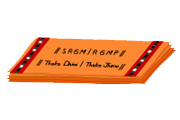Posted By: Administrator
Rāga: Sindhu Bhairavi
Thāḷa: Ādhi
Composer: Purandhara Dhāsa
Language: Sanskrit
Meanings
–Word by word & overall: R.Shankar – rasikas.org
(Meanings –Word by word & overall: Charaṇam 1 – Team Ambalam)
Alignment, Diacriticals &
consequent spelling changes, Language & grammar editing, if any and
necessary, of existing meaning: Team Ambalam
Pallavi
Venkaṭāchala Nilayam Vaikunṭha Pura Vāsam
Pankaja Nethram Parama Pavithram
Śhankha Chakra Dhhara Chinmaya Rūpam
Venkaṭāchala Nilayam Vaikunṭha Pura Vāsam
Anupallavi
Ambujodhbhava Vinutham Agaṇitha Guṇa Nāmam
Thumburh Nāradha Gaṇa Vilolam Ambudhiśhayanam Āthmābhirāmam
Venkaṭāchala Nilayam Vaikunṭha Pura Vāsam
Charaṇam 1
Pāhi Pāṇḍava Pakṣham Kaurava Madhaharaṇam
Bahu Parākrama Pūrṇam
Ahalyā Śhāpa Bhaya Nivāraṇam
Venkaṭāchala Nilayam Vaikunṭha Pura Vāsam
Charaṇam 2
Sakala Vedha Vichāram Sarvajīvana Karam
Makara Kunḍala Dhhara Madhana Gopālam
Bhaktha Pośhaka Śhrī Purandhhara Viṭhalam
Venkaṭāchala Nilayam Vaikunṭha Pura Vāsam
Meanings:
Pallavi
Venkaṭāchala Nilayam Vaikunṭha Pura Vāsam
Pankaja Nethram Parama Pavithram
Śhankha Chakra Dhhara Chinmaya Rūpam
(Venkaṭāchala Nilayam Vaikunṭha Pura Vāsam )
Venkaṭāchala Nilayam = the one who is established in Venkaṭāchala (Thirupathi);
Vaikunṭha Pura Vāsam = one who is the resident
of Vaikunțha ;
Pankaja Nethram = with lovely, long eyes like a lotus;
Parama Pavithram = is also the supremely sacred one;
Śhankha Chakra Dhhara = holding the conch (Pānchajanyam) and wields the discus (Sudharśhana
Chakram) ;
Chinmaya Rūpam = embodies the spiritual
presence.
He,
who lives on the Venkata mountain; he who lives in Vaikunțha; he, who has lotus
like eyes, he who is divinely pure, he who has the divine form, carrying the
conch and the wheel.
Anupallavi
Ambujodhbhava Vinutham Agaṇitha Guṇa Nāmam
Thumburh Nāradha Gaṇa Vilolam Ambudhiśhayanam Āthmābhirāmam
(Venkaṭāchala Nilayam Vaikunṭha Pura Vāsam)
Ambujodhbhava
Vinutham = one who is praised by Brahmā ;
Agaṇitha =
Guṇa Nāmam = one whose very name symbolizes countless sterling character
traits;
Thumburu Nāradha
Gāna
Vilolam = one who delights in the music/song of the celestial bards like
Nāradha
He who is worshipped by Brahma, he who
has innumerable names and characters,
he who enjoys music by Nāradha and Thumburu.
Note: Ambujodhbhava - originating - udhbhava - from a lotus - ambuja - in
Vishnu's navel - hence Padhmanābha - Annamāchārya refers to this in his Mohanam
krithi - cheri yaśhodhaku śhiśhu īthaḍu, dhāruni brahmaku thanriyunīthaḍe - he
is the son of Yaśhodhā and the father of Brahmā)
Charaṇam 1:
Pāhi Pāṇḍava Pakṣham Kaurava
Madhaharaṇam
Bahu Parākrama Pūrṇam
Ahalyā Śhāpa Bhaya Nivāraṇam
(Venkaṭāchala Nilayam Vaikunṭha Pura Vāsam )
Pāhi
Pāṇḍava Pakṣham - Protector of the Pāṇḍavas;
Kaurava
Madha
haraṇam – the destroyer of the arrogance of the Kauravas;
Bahu
Parākrama
Pūrṇam – one who is completely strong;
Ahalyā
Śhāpa
Bhaya
Nivāraṇam – the remover of fear of the curse of Ahalyā.
The protector of the Pāṇḍavas, the destroyer
of the arrogance of the Kauravas, one who is completely strong and the remover
of fear of the curse of Ahalyā.
Charaṇam2:
Sakala Vedha Vichāram Sarvajīvana
Karam
Makara Kunḍala Dhhara Madhana Gopālam
Bhaktha Pośhaka Śhrī Purandhhara Viṭhalam
(Venkaṭāchala Nilayam Vaikunṭha Pura Vāsam )
Sakala Vedha
Vichāram – the
subject of all Vedhas;
Sarvajīvana
Karam - the cause of all life;
Makara Kunḍala
Dhhara = adorned with crocodile shaped ear-rings;
Madhana Gopālam = you are the handsome one and you who herded cows;
Bhaktha
Pośhaka
Śhrī Purandhhara
Viṭṭhalam = you are Śhrī Purandhhara Viṭṭhala, who protects
his devotees
The Gopala
who is the subject of all Vedhas, the cause for all life, who is like the god
of love, who herds cows, who wears golden ear studs which are crocodile shaped,
that Purandhara Viṭțhala who looks after
devotees.(he resides in the mountains of Thirupathi)
Note: I have also heard that go can also mean senses, and hence Gopāl
not only herded cows in Bhrundhāvan during Dhwāparayuga, but continues to herd
our senses in Kaliyuga.












